Heredity & Variation Class 12 Notes Biology
Some Important Terms
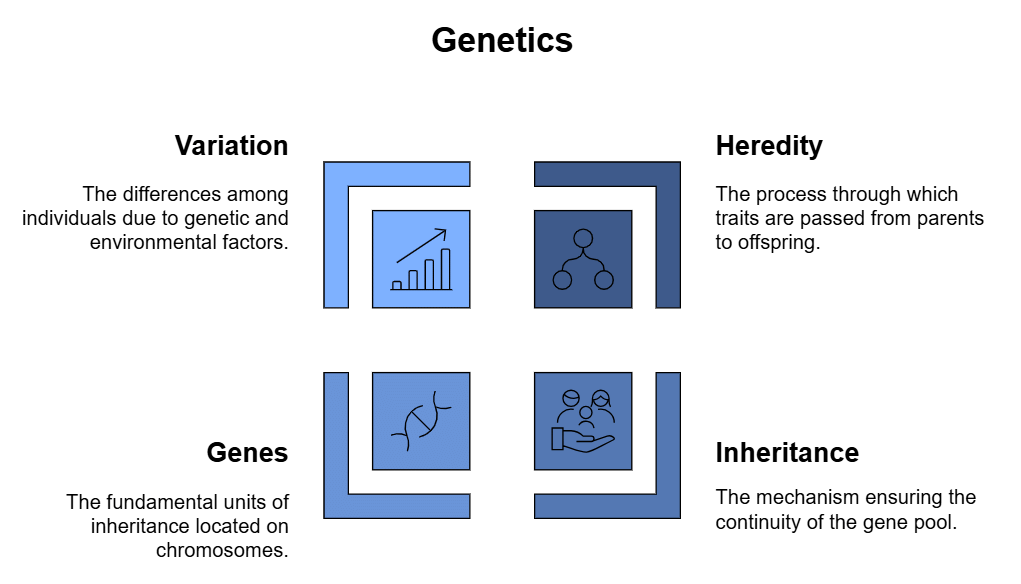
- Heredity
- Genetics is the branch of biology dealing with the principles and mechanism of inheritance and variation.
- Inheritance is the basis of heredity and by this process, traits are passed on from the parents to the offsprings. Continuity of the gene pool is maintained by the process of inheritance.
- Genes are the basic unit of inheritance and located on chromosomes.
- Variation exists among individuals of one species. Variation is due to crossing over, recombination, mutation and environmental effects on the expression of genes present on chromosomes.
Mendel's Law of Inheritance
- Mendel performed experiments on Garden pea. He took 14 true-breeding plants of pea having seven distinguishable characters, which have two opposite traits.
- He called genes as “factors”, which are passed from parents to offsprings.
- Genes, that code for a pair of opposite traits are called “alleles”.
- Mendel’s experiment involved 4 steps as selection, hybridization, selfing and calculations. His results led to the formation of laws of genetics later.
- Mendel performed monohybrid and dihybrid crosses and gave three principles of inheritance.
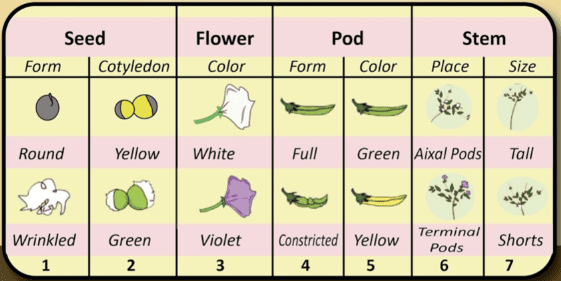 Mendel's Pea Plant Traits
Mendel's Pea Plant Traits
Mendel’s three principles of inheritance are:
- Law of dominance
- Law of segregation or law of purity of gametes
- Law of independent assortment
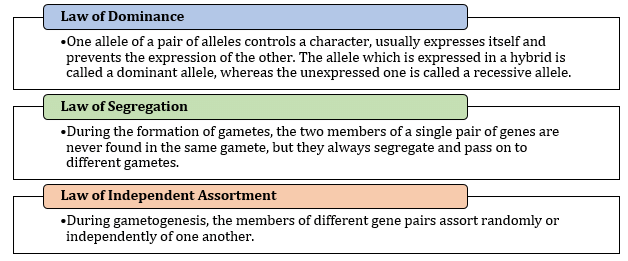
Test Cross
- A cross between F1 hybrid (Aa) and its homozygous recessive parent (aa) is called Test Cross. This cross is called test cross because it helps to find out whether the given dominant phenotype is homozygous or heterozygous.
Monohybrid Cross
- When we consider the inheritance of one character at a time in a cross, this is called monohybrid cross.
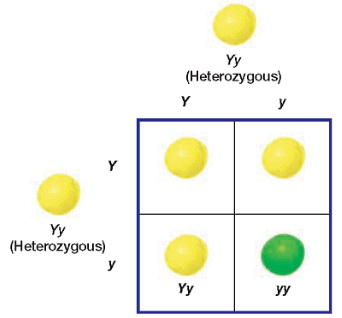 Dihybrid Cross
Dihybrid Cross
- A cross made to study the inheritance of two pairs of contrasting traits.
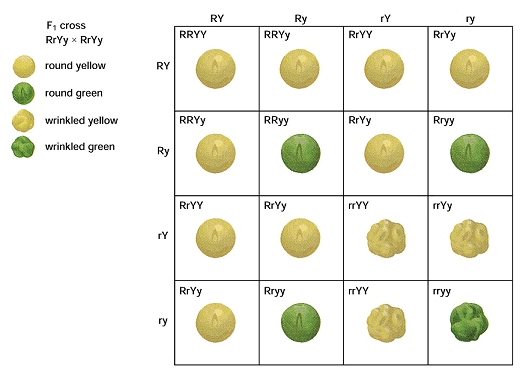
Exceptions of Conclusions of Mendel
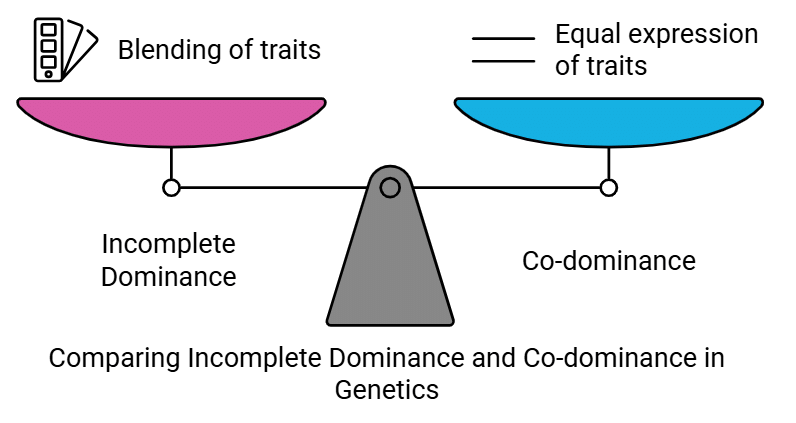
(a) Incomplete Dominance
- When neither of the alleles of a character is completely dominant over the other and the F1 hybrid is intermediate between the two parents, the phenomenon is called incomplete dominance.
- Incomplete dominance was first discovered by Correns in Mirabilis jalapa. The plant is called as 4’O clock plant or ‘Gul-e-Bans’. Homozygous red (RR) flowered variety of the plant was crossed with white (rr) flowered variety. F1 offspring had pink flowers (Rr). This is called incomplete dominance.
- Incomplete dominance is also known to occur in snapdragon. The phenotypic ratio and genotypic ratio in F2 generation in case of incomplete dominance is 1:2:1.
(b) Co-dominance
- In co-dominance both the gene expressed for a particular character in F1 hybrid progeny. There is no blending of characters, whereas both the characters are expressed equally.
- Co-dominance is seen in animals for coat colour. When a black parent is crossed with white parent, a roan color in F1 progeny is produced.
Sex Determination
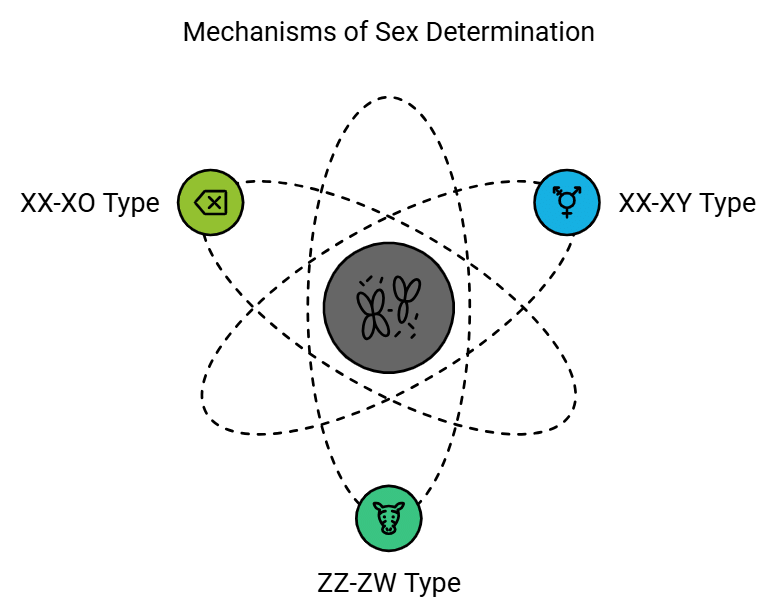
- Fixing the sex of an individual as it begins life is called sex determination. The various genetically controlled sex-determination mechanisms have been classified into following categories
- Chromosomal theory of sex determination: The X-chromosome was first observed by German biologist, Henking in 1891 during the spermatogenesis in male bug and was described as X-body. The chromosome theory of sex determination was worked out by E.B. Wilson and Stevens (1902-1905).
- They named the X and Y chromosomes as sex-chromosomes or allosomes and other chromosomes of the cell as autosomes.
- Sex chromosomes carry genes for sex. X-chromosomes carries female determining genes and Y-chromosomes has male determining genes.
- The number of X and Y chromosomes determines the female or male sex of the individual, Autosomes carry genes for the somatic characters. These do not have any relation with the sex.
 |
Download the notes
Revision Notes: Principle of Inheritance and Variation
|
Download as PDF |
Sex Determination by Chromosomes
Those chromosomes which are involved in the determination of sex of an individual are called sex chromosomes while the other chromosomes are called autosomes.
- XX – XY type: In most insects including fruit fly Drosophila and mammals including human beings the females possess two homomorphic sex chromosomes, named XX. The males contain two heteromorphic sex chromosomes, i.e., XY. Hence the males produce two types of gametes / sperms, either with X-chromosome or with Y-chromosome, so they are called Heterogamety.
- ZZ – ZW type: In birds and some reptiles, the males are represented as ZZ (homogamety) and females are ZW (heterogamety).
- XX – XO type: In round worms and some insects, the females have two sex chromosomes, XX, while the males have only one sex chromosomes X. There is no second sex chromosome. Therefore, the males are designated as XO. The females are homogametic because they produce only one type of eggs. The males are heterogametic with half the male gametes carrying X-chromosome while the other half being devoid of it.
Ways of Chromosomal Mutation
Mutation is an abrupt and discontinuous process where a gene or a chromosome undergoes heritable change in its structure or number.
Numerical Aberrations of Chromosomes
Each species has a characteristic number of chromosome. Variations or numerical changes in chromosomes (Heteroploidy) can be mainly of two types:
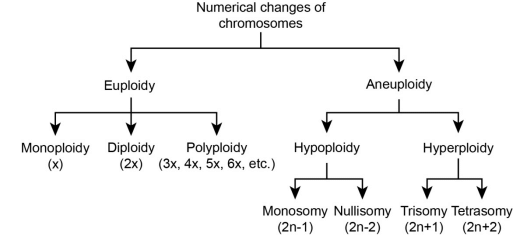
1. Euploidy: The somatic chromosome number in euploids is the exact multiple of basic haploid number. In euploidy an organism acquires an additional set of chromosomes over and above the diploid complement.
- Monoploidy or haploidy: Monoploids possess only one set or single basic set of chromosomes. Haploids on the other hand have half the somatic chromosome number. In diploid organisms monoploids and haploids are identical while in a tetra-or hexaploid with 4n or 6n chromosomes the haploids will possess 2n or 3n chromosome whereas its monoploid will possess only one set (n) of chromosome.
- Diploidy: The common chromosome number in the somatic cells of plants and animals.
- Polyploidy: Organism with more than two sets of chromosomes are known as polyploids. It may be triploid with three sets of chromosomes (3n) or tetraploid with four sets of chromosome (4n) and so on.
2. Aneuploidy: Aneuploidy is the term applied for the chromosomal mutations involving only a part of a set, i.e., loss (hypoploidy) or addition (hyperploidy) of one or more chromosomes. Aneuploidy may result from non disjunction of chromosome during cell division.
- Monosomy: Diploid organism that are missing one chromosome of a single pair with genomic formula 2n – 1. Monosomics can form two kinds of gametes, (n) and (n –1).
- Nullisomy: An organism that has lost a chromsome pair is nullisomic. The result is usually lethal to diploids (2n – 2).
- Trisomy: Diploids which have extra chromosome represented by the chromosomal formula 2n + 1. One of the pairs of chromosomes has an extra member, so that a trivalent may be formed during meiotic prophase.
- Tetrasomy: In tetrasomic individual particular chromosome of the haploid set is represented four times in a diploid chromosomal complement. The general chromosomal formula for tetrasomics is 2n + 2 rather than 2n + 1+ 1. The formula 2n + 1 + 1 represents a double trisomic.
3. Types of aneuploidy: Aneuploidy may be of following types on the basis of chromosomes involved in non disjunction.
(i) Aneuploidy involving non-disjunction in sex chromosomes:
This kind of aneuploidy is brought about due to non-disjunction in sex chromosomes. It may lead to following types of syndromes:
- Turner’s syndrome: Such persons are monosomic for sex chromosomes i.e. possess only one X and no Y chromosome (XO). In other words they have chromosome number 2n – 1 = 45. They are phenotypic females but are sterile because they have under developed reproductive organs. They are dwarf about 4 feet 10 inches and are flat chested with wide spread nipples of mammary glands which never enlarge like those in normal woman. They develop as normal female in childhood but at adolescence their ovaries remain under developed. They lack female hormone estrogen. About one out of every 5,000 female births results in Turner’s syndrome.
- Klinefelter’s syndrome: Since 1942, this abnormality of sex is known to geneticists and physicians. It occurs due to Trisomy of sex chromosomes which results in (XXY) sex chromosomes. Total chromosomes in such persons are 2n + 1 = 47 in place of 46. Klinefelter (1942) found that testes in such male remain under developed in adulthood. They develop secondary sex characters of female like large breasts and loss of facial hair. Characters of male develop due to Y chromosome and those like female due to XX chromosomes. About one male child out of every 5,000 born, develops Klinefelter’s syndrome.
Such children are born as a result of fertilization of abnormal eggs (XX) by normal sperms with (X) or (Y) chromosomes or by fertilization of normal eggs with (X) chromosomes by abnormal sperms with (XY) chromosome. They are sterile males mentally retarded and are eunuchs.
(ii) Aneuploidy involving non-disjunction in autosomes:
This type of aneuploidy occurs due to trisomy of autosomes. In any particular autosomal pair having 3 instead of normal 2 chromosomes. Such persons may be males 45 + XY = 47(2n + 1) or females 45 + XX =47(2n + 1). On the basis of the number of the autosome pair affected by trisomy, they can be of following types
- Down’s syndrome: This autosomal abnormality is also known as Mongolian idiocy or mongolism. In Langdon Down of England (1866) studied the Mongolian idiocy and described the trisomic condition of their chromosomes. Down’s syndrome, a very common congenital abnormality arises due to the failure of separation of 21st pair of autosomes during meiosis. Thus an egg is produced with 24 chromosomes instead of 23. A Down’s syndrome has 3 autosomes in 21st pair instead of 2. Total number of chromosomes in this case is 2n + 1 (21st) = 47.
The affected children have a very broad fore head, short neck, and flat palms without crease, stubby fingers, permanently open mouth, projecting lower jaw and a long thick extending tongue. They have low intelligence and are short heighted. They have defective heart and other organs. They are born to mothers aged 40 year and above during first pregnancy. They may survive upto 20 years under medical care.
They are called mongolian idiots because of their round, dull face and upper eyelids stretched downwards similar to mongolian race.
Chromosomal Theory of Inheritance
- Chromosomal theory of inheritance was proposed by Sutton and Boveri independently in 1902. The two workers found a close similarity between the transmission of hereditary characters and behaviour of chromosomes while passing from the one generation to the next through agency of gametes.
Pedigree analysis: Inheritance of hundreds of characteristics such as polydactyly, haemophilia, colour blindness, attached ear lobes and tongue rolling, generation after generation in particular families of man have been studied.
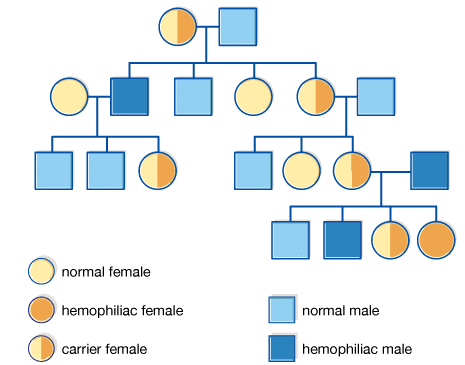 Pedigree Analysis
Pedigree Analysis
In order to conduct such study, a standard method has been used to represent the family pedigree in a concise, easily understood form so that one can visualize the entire pedigree (family history) at a glance of the chart.
FAQs on Heredity & Variation Class 12 Notes Biology
| 1. What are Mendel's Laws of Inheritance? |  |
| 2. What are some exceptions to Mendel's conclusions? |  |
| 3. How is sex determination achieved in humans? |  |
| 4. What is the significance of Mendel's work in genetics? |  |
| 5. How do Mendel’s laws apply to real-world genetics? |  |


















